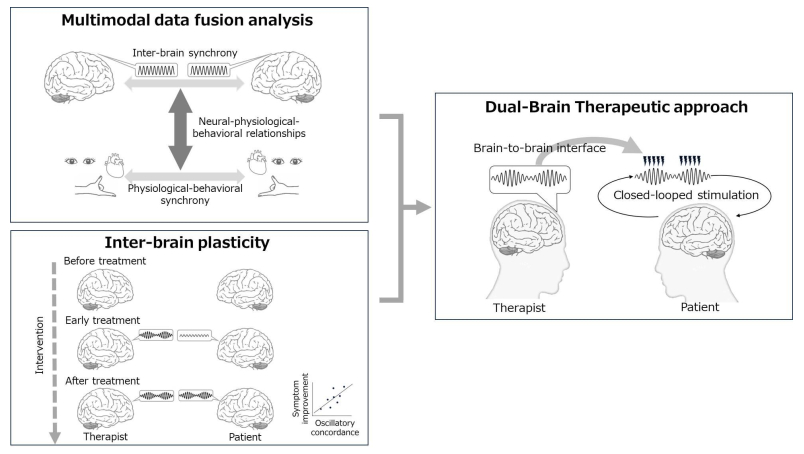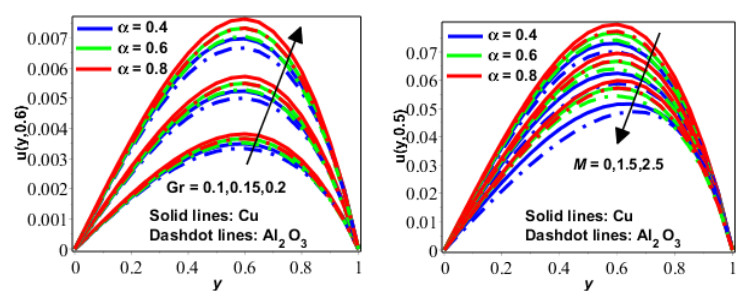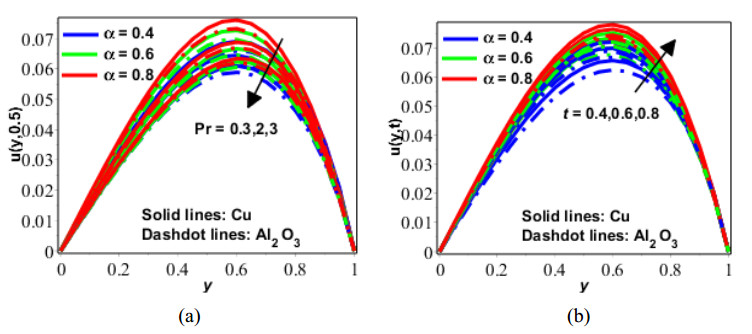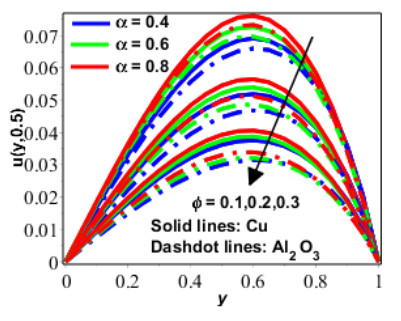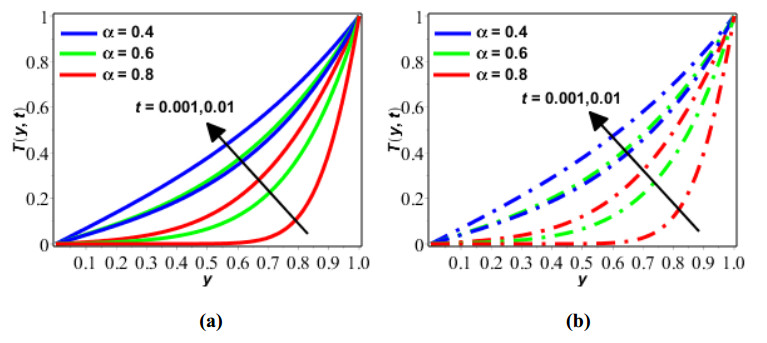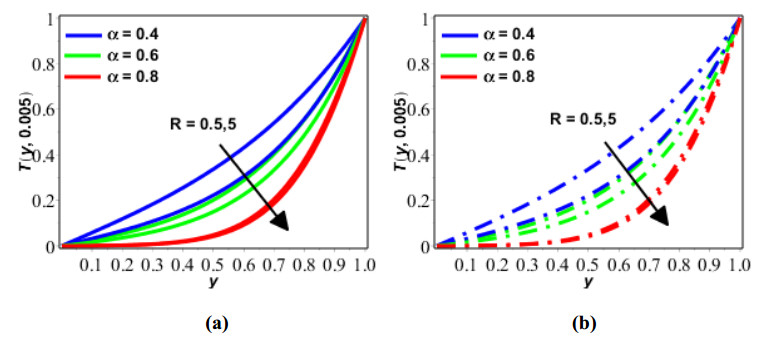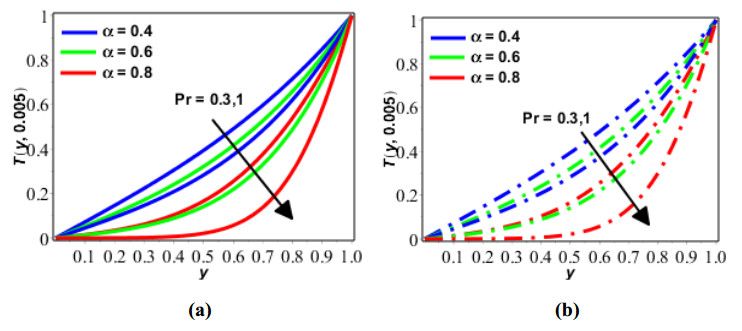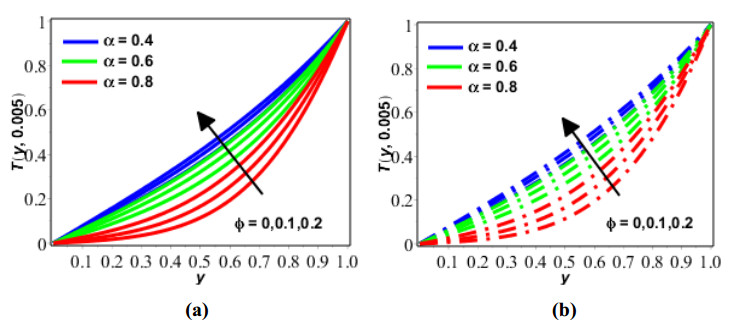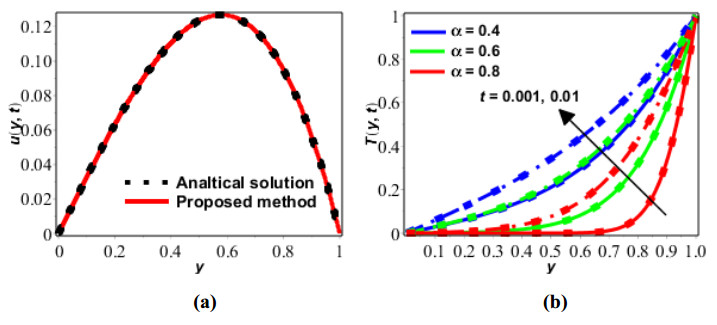In the current article, we analyzed the unsteady natural convection with the help of fractional approach. Firstly, the unsteady natural convection radiating flow in an open ended vertical channel beside the magnetic effects. We assumed the channel is stationary with non-uniform temperature. Secondly, we utilized a fractional calculus approach for the constitutive relationship of a fluid model. The modeled problem is transformed into nondimensional form via viable non-dimensional variables. In order to investigate the numerical solutions of non-dimensional system of partial differential equations finite difference approach coupled with Crank Nicolson method is developed and successfully applied. The beauty of Crank Nicolson finite difference scheme is, this scheme is unconditionally stable. A very careful survey of literate witnesses that this scheme has never been reported in the literary for fluid problems. The physical changes are discussed with the help of graphics. The expression for both velocity field and temperature distribution has been made via said scheme. A comprehensive discussion about the influence of various related dimensionless parameters upon the flow properties disclosed our work. It is observed that velocity field decreases as enhancing the magnetic field effects. Heat transfer enhanced as enhancing the nanoparticle volume fraction parameter. Velocity field and heat transfer shows the dominant behavior for the case of Cu-based nanofluid as compare to Al2O3 based nanofluid. Comparative study also included to show the accuracy of the proposed finite difference scheme. It is to be highlighted that the proposed scheme is very efficient and well-matched to investigate the solutions of modeled problem and can be extended to diversify problems of physical nature.
1.
Introduction
Our everyday actions and decisions are heavily influenced by communicative behaviors with others such as cooperating, competing, imitating, helping, playing, providing information, asking questions, negotiating, bargaining, and bluffing [1]. These communications are called social interactions and are dynamic feedback loops that link actions, reactions, and internal cognitive processes between individual agents [2,3]. Social interactions are associated with interpersonal synchrony that occurs at multiple biobehavioral levels of behavioral, physiological, and hormonal activity [4,5,6,7]. Moreover, temporally simultaneous patterns of cognitive alignment and communicative behaviors during social interactions can align neural activities across individuals [2,8].
The focus of studies on the neural mechanisms underlying social interactions has shifted from single individuals to interactions between individuals. This paradigm shift is known as "second-person neuroscience" or "interpersonal neuroscience" [9,10]. Hyperscanning- a neuroimaging technique that simultaneously measures the activity of multiple brains- is a powerful second-person neuroscience tool for investigating the phase alignment of neural processes during social interactions. Neural synchronization revealed by hyperscanning is a phenomenon called inter-brain synchrony (IBS), which purportedly supports social interaction by aligning the neural activity of dyads [7,11] and groups [12,13]. IBS may be associated with the transfer of information between brains, as the phase alignment of neural activities facilitates the efficient transfer of information between multiple regions within a single brain [14]. This may represent an adaptive capacity that allows people to access the internal arousal state of others; share and regulate emotions; enhance social affiliation, empathy, and prosocial engagement; and facilitate learning [7,8,15,16].
Human hyperscanning studies have identified several brain regions involved in IBS, including the prefrontal cortex (PFC) [17,18], anterior cingulate cortex [19], superior temporal gyrus [20,21], temporoparietal junction (TPJ) [22], and insular cortex [23]. Brain regions associated with IBS are involved in theory of mind [24], predictive processing [25], mirroring [26], and social cognition [27], which have been shown to play important roles in social interactions [28,29]. These hyperscanning results support the hypothesis that IBS reflects complex cognitive processes, including mentalization, prediction, imitation, and simulation of behavioral and affective states during social interactions [7]. These brain regions are expected targets for the modulation of human social functions using noninvasive brain stimulation (NIBS), which can change cortical excitability using repetitive transcranial magnetic stimulation and transcranial direct current stimulation [30,31,32]. However, few direct associations have been identified with the rich field of NIBS, although the development of second-person neuroscience has provided opportunities to uncover the neural mechanisms of social interactions and to study how interpersonal brain activity shapes social behavior. Rather than stimulating a single brain, a dual-brain approach using NIBS across individuals can help control social interactions by manipulating communication between the brains.
This review explored the possibility of a dual-brain therapeutic approach using NIBS to modulate social interactions based on the current knowledge of IBS. First, it provides an overview of the methods used to analyze IBS through hyperscanning, a neuroimaging technique that simultaneously measures the activity of multiple brains. Multimodal data fusion analysis of behavioral, physiological, and neural activity across individuals- helps elucidate the neurobiological mechanisms of IBS. This review discusses multi-brain stimulation (MBS) using NIBS to modulate inter-brain communication. The simultaneous manipulation of brain activity helps elucidate the causal role of IBS in social interactions. Next, I discuss the possibility of clinical application using the dual-brain approach for facilitating social interactions as an adjunctive technique to physiotherapy, psychotherapy, and pain treatment, the effectiveness of which is strongly influenced by interactive communication between the therapist and patient. Finally, I discuss the future directions of dual-brain approaches to personalize stimulation parameters by considering temporal, spatial, and oscillatory factors.
2.
Methods of assessing IBS
Electroencephalography (EEG), magnetoencephalography (MEG), functional near-infrared spectroscopy (fNIRS), and functional magnetic resonance imaging (fMRI) are used to measure multibrain activity in hyperscanning research. EEG and MEG record cortical activity with a high temporal resolution, allowing the study of high-frequency dynamics and network patterns. fNIRS can be used to record the cortical hemodynamic activity without strict behavioral constraints. Compared to other neuroimaging techniques, fMRI offers the best opportunity for brain-wide access to neural signals; however, its technical limitations exclude tasks involving physical interactions [2,3]. Table 1 lists the commonly used analytical methods and provides a brief description of their characteristics. This review was not intended for detailing any of the IBS assessment methods. I recommend the excellent earlier reviews for further details [3,33,34,35,36].
Several analytical methods are used to estimate the covariance or directional neural coupling of the time series produced by two interacting individuals on EEG and MEG. Common analyses of IBS in electrophysiological studies use intra-brain estimators such as the Phase Locking Value (PLV) [56], Inter-brain Phase Coherence (IPC) [40], and Partial Directed Coherence (PDC) [44]. While PLV and IPC measure the phase synchrony between neural signals, PDC is useful for determining the direction of synchrony between neural signals in a dyad [33,34]. The other IBS analyses used include Pearson's correlation coefficient, Spearman's correlation coefficient, circular correlation coefficient, and wavelet transform coherence (WTC) [34]. Time series correlation analyses that measure symmetric effects provide a simple measure of shared dynamics between brains but may miss out-of-phase synchronous relationships [2]. This is because many social interactions are asymmetrical with two participants playing different roles [57]. The WTC was developed for the analysis of geophysical time series [58] and has mainly been used for the analysis of fNIRS hyperscanning studies [33]. Analyses using fMRI hyperscanning include coherence analysis [21,59], inter-subject correlation [54], and inter-subject functional connectivity [55]. Other analyses such as Granger causality and dynamic causal modeling, have been used to reveal temporal relationships and inter-brain information flow [60,61,62]. Although there are various methods of analysis, as described above, and each estimation, analysis, and hyperscanning technique has its advantages and limitations, there is no uniform method for assessing IBS [33,34]. In addition, there is a lack of studies comparing the quantitative results of IBS in the field of hyperscanning research [36]. The lack of established standard methods makes it difficult to resolve the issues arising from ambiguity in the definition and theory of IBS. Therefore, common analysis guidelines should be established to facilitate the replication of results and their interpretation [63,64].
The behavioral coding approach is helpful for quantifying the extent to which specific communicative behaviors contribute to IBS, thereby interpreting neural-behavioral relationships [57,65,66,67]. However, the subjective nature of behavioral coding raises reliability concerns, even when a detailed coding scheme is provided and multiple raters participate. Therefore, the use of automated algorithms, such as Motion Energy Analysis and OpenPose, to extract behavioral information from video recordings should be considered. Motion Energy Analysis is a computer vision technique based on assessing differences in sequences of frames in video recordings, which can provide a continuous measure of motion [68]. The OpenPose system is a real-time multiperson 2D pose estimation system that uses Part Affinity Fields and is capable of tracking human interactions from the body, foot, hand, and face keypoints in images or videos [69]. Moreover, for behavioral activities, IBS is comodulated by physiological activities such as heart rate, pupil size, and saccade rate [6]. Therefore, IBS assessment techniques should be developed to capture rich information about physiological changes in addition to participants' behaviors such as facial expressions and hand and body movements [57,65,70]. Integrating data that capture behavioral, physiological, and neural interactions between individuals can reveal the underlying mechanisms of social interactions that cannot be inferred from IBS alone [7,57]. In addition, the machine learning-based decoding approach, which builds mathematical models based on sample data to automatically classify activities, can provide valuable information on whether IBS serves as a neural classification feature that optimizes the decoding of interpersonal multimodal activities during social interactions [8].
3.
Multiple brain stimulation (MBS)
IBS, revealed by hyperscanning, may be a neural mechanism that facilitates social interactions by prompting appropriate anticipation and response to each other's social behaviors during ongoing shared interactions [71,72]. Therefore, artificially modulating IBS using neurofeedback and MBS has the potential to improve social interaction. Multi-brain neurofeedback using brain-computer interface technology involves providing real-time feedback of brain activity to interacting individuals, potentially enabling them to regulate IBS [73,74,75]. Some brain dynamics observed during the multi-brain neurofeedback task correlated with communicative behaviors, suggesting a link between cognitive and emotional states [73]. However, multi-brain neurofeedback approaches have the disadvantage that feedback learning takes time; and detailed phase shifts are not easily implemented. However, MBS using NIBS can easily reproduce different stimulation phase shifts between the brains and respond to cases in which the oscillatory activity between the brains may not be fully synchronized. In humans, rhythmic NIBS such as transcranial magnetic stimulation (TMS) and transcranial alternating current stimulation (tACS) can be used to simultaneously stimulate multiple brains by entraining brain oscillations. TMS creates a local magnetic field to stimulate the cortex through the scalp using wire coils placed on the scalp. When a pulsed magnetic field enters the brain, it creates an electric current that flows through neurons, causing them to depolarize [76]. In contrast, tACS uses a weak oscillating current stimulation applied to the brain via scalp electrodes to drive neuronal activity into these frequency patterns [77,78]. These NIBS entrainment designs generally match the stimulation frequencies to those of the underlying brain activity because computational modeling suggests that brain activity entrapment is characterized by an increased likelihood of "resonance" of oscillatory brain activity when the stimulation frequency matches that of the underlying brain oscillations [79,80]. However, no studies have used TMS to manipulate communication between the brains, and tACS has mainly been used for MBS in human studies [81]. tACS can induce functional connectivity between distant regions of the brain by modulating the phase synchrony of oscillations [77,82]. As an application of intra- to inter-brain communication, tACS applied simultaneously to two brains, known as hyper-tACS, aims to manipulate the oscillation frequencies between brains and artificially induce IBS.
IBS has mainly been reported in slower frequency bands, such as theta (4–7 Hz) [19,41,83,84] and alpha-mu (8–13 Hz) [37,47,85,86,87], but it has also been reported in beta (14–30 Hz) [19,88,89] and gamma (30–80 Hz) bands [20,22,38,90]. Matching the stimulation frequency of the NIBS to the neural oscillations associated with the brain regions and behavioral contexts may be effective for entrainment; however, in the case of artificial IBS modulation, it is necessary to consider not only within the brain but also the interactions between brains. Interactions between brains can be thought of as long range, with low frequencies suitable for integrating information across distant areas. There are fewer constraints on timing accuracy at lower frequencies because the excitability rise and fall periods are longer [91,92]. Computational simulations also suggest that low frequencies such as theta oscillations are associated with the sharing of belief states when communicating [93]. However, the specific neural oscillations associated with IBS are currently not well understood, so for future MBS studies using tACS, I will outline the characteristics of other oscillation bands associated with IBS. The alpha-mu-band is the most robust oscillation in IBS during social interactions [94]. However, alpha-band oscillations are well-established neural activities related to attention [95,96]. Attention to relevant cues may enhance common neural processing, leading to meaningless synchronized neural oscillations unrelated to social interaction. Therefore, alpha IBS during social interactions should be interpreted with caution [63,97]. As beta-band oscillations are associated with motor processes [98,99], a relationship between beta oscillations and movement synchrony during social interaction might be expected. However, the results for the beta band IBS involved in movement synchrony have been inconsistent [19,40,89,100]. Gamma oscillations have been associated with several neurocognitive processes like: Information processing, conscious perception, and memory [101]. Given these relationships, the gamma band appears to be associated with cognitive processes, such as social interaction. However, this is too fast for the multiple brains to interact with. Even the slowest gamma frequencies oscillate within approximately 30 ms. Therefore, brains interacting at gamma frequencies must establish and maintain IBS with a half-cycle accuracy of at least 15 ms [63]. This is likely not possible given that the duration of the excitatory postsynaptic potential is approximately 10 ms [102]. Therefore, IBS at gamma frequencies has often reported, but its role in social interactions is questionable [63].
Few studies have reported on hyper-tACS [103,104,105]. Novembre et al. reported that hyper-tACS increases interpersonal synchrony. In-phase 20-Hz tACS applied to the motor cortex in dyads performing a finger-tapping task improved interpersonal movement synchrony compared to anti-phase or sham stimulation. The phase coupling of brain oscillations across the motor cortices of two individuals may support the interpersonal alignment of sensorimotor processes, resulting in the facilitation of interpersonal synchrony [103]. Pan et al. reported that hyper-tACS applied to the inferior frontal cortex improved instruction-based learning. In-phase 6-Hz hyper-tACS applied to the instructor and learner improved the learning performance of naturalistic song-learning tasks [105]. In addition, body movement synchrony of the dyads was increased by hyper-tACS. In contrast, another study reported that in-phase 6-Hz hyper-tACS applied to the right frontocentral and centroparietal sites during a dyadic drumming synchrony task worsened interpersonal action coordination [104]. The hyper-tACS frequency, location, and phase may have been inappropriate for facilitating this dyadic task since it deteriorated the interpersonal coordination. Furthermore, it may not be necessary for the two brains to synchronize at the same frequency. Brain oscillations can be coupled with activity in other brains at lower frequencies, known as cross-frequency coupling (CFC), where one stimulation band modulates another band between different regions of the brain [106].
Thus, how neural oscillations are coupled between brains remains poorly understood, and future studies on dual-brain approaches using NIBS to modulate social interactions will need to consider the possibility of temporal, spatial, and frequency asymmetries in brain activity between participants. Additionally, electrical stimulation applied to the scalp, such as tACS, is often associated with peripheral sensations [107]. Therefore, brain regions unrelated to task function should be examined as controls to exclude the possibility that changes in social interactions by hyper-tACS are due to sensory stimulation effects. Furthermore, future studies should investigate whether the experimental modulation of IBS could affect the degree of social interaction to deny that IBS is not purely epiphenomenally induced by other forms of neural synchrony, such as behavioral entrainment, cognitive alignment, shared understanding, and affective contagion. Experimental hyper-tACS, which simultaneously manipulates neural activity in interacting partners, could help clarify the causal role of IBS in social interactions by modulating IBS and measuring its influence on social interactions [108]. However, the potential causal mechanisms of IBS, including behavioral entrainment, shared understanding, and affective contagion, are not mutually exclusive and may collaborate to facilitate neural coupling [8].
4.
Potential therapeutic dual-brain approach using NIBS
The effectiveness of psychotherapy, physiotherapy, and pain treatment is influenced by the therapist–patient relationship [109,110,111,112]. Therefore, the dual-brain approach using NIBS aimed at facilitating social interaction may be an adjunctive approach in clinical situations that are strongly influenced by interactive communication with others. Impaired social interactions are one of the most common symptoms of many psychiatric disorders. The study of the neural mechanisms underlying interactions between individuals in the field of psychiatry is referred to as second-person neuropsychiatry [113,114]. Disturbances in inter-brain dynamics may have a negative impact on social function, because brain-brain coupling may trigger neural mechanisms that control social alignment, such as cooperation and affective contagion. In line with this, it has been investigated how the dynamics between the brains may be altered in mental and neurodevelopmental disorders associated with social deficits. Previous studies reported abnormal IBS during interactions between healthy individuals and patients with autism spectrum disorder (ASD), a neurodevelopmental disorder characterized by deficits in interpersonal interactions and social communication [51,115]. Wang et al. reported that children with more severe ASD symptoms showed lower IBS levels in the PFC with their parents during cooperative tasks [51]. In addition to ASD, IBS is reduced in the right TPJ during the cooperation task in healthy individuals and patients with borderline personality disorders compared to those observed in healthy dyads [116]. Furthermore, low IBS has not been observed between healthy individuals and remitted patients with borderline personality disorders. Using fNIRS hyperscanning, Zhang et al. found that IBS in the right TPJ between counselors and clients increased during psychological counseling, which correlated with the strength of the therapeutic alliance [117]. A deeper understanding of the dynamics between the brains of different patients may reveal the common neural mechanisms of different psychiatric disorders as well as diagnostic tools for patient heterogeneity, potentially leading to prosocial therapeutic approaches for psychotherapy.
Social interactions between therapists and patients are important in physiotherapy, in which therapists instruct patients to improve their motor impairments. Instruction is not just a one-way transmission of information from instructors to learners; rather, it is a complex social interaction that requires mentalizing and metacognitive functions to understand others' intentions and monitor information about others in addition to oneself [118]. Much evidence suggests that the IBS in the PFC increases during instruction-based learning [17,18,119]. A meta-analysis of 16 hyperscanning studies also concluded that IBS levels during the teaching-learning interactions correlates with better learning outcomes [120]. The PFC plays a central role in metacognitive processes [121,122]. Furthermore, PFC is associated with shared intentionality, requiring individuals to align their thoughts with others to promote coordinated behavior [52]. Patients with brain damage, such as stroke and traumatic brain injury, who require physiotherapy, often have impaired metacognitive and mentalizing functions. These cognitive impairments lead to poor rehabilitation outcomes [123,124,125,126]. The interpersonal neural entrainment induced by oscillatory synchronization through phase alignment can facilitate the efficient transfer of information from one brain to another, resulting in better social interaction during instruction-based learning [66,127]. Consistent with this, in-phase theta hyper-tACS applied to the inferior frontal cortex in both instructors and learners enhanced interactive social learning [105]. Artificial induction of IBS can help physiotherapy by enhancing instruction-based learning between the therapist and patient.
It is well known that interpersonal interactions relieve pain [128,129]. Pain empathy allows us to understand and recognize others' pain experiences by observing them and inducing the sharing of emotions related to pain relief [128,130]. A previous EEG hyperscanning study investigated the neural mechanisms underlying pain empathy when one participant in a dyad was presented with an electrical pain stimulus [39]. This study shows that the IBS of the sensorimotor alpha oscillation band between pain sufferers and observers was greater during the anticipation of high-intensity pain than during low-intensity pain. In addition, the mediation analysis showed that the sharing of a painful experience induced prosocial behavior within pairs of individuals via IBS. Another study using EEG hyperscanning found that when romantic partners held hands, the alpha oscillation band in the centro-parietal regions increased during pain stimulation [47]. IBS also correlated with the degree of pain relief and touch-related empathic accuracy of the observer. An fMRI hyperscanning study investigated the concordance of brain activity when clinicians treated evoked pain in patients with chronic pain [131]. Behavioral mirroring was reportedly associated with pain relief and therapeutic alliance between patient–clinician dyads and that dynamic concordance of brain activity increased in circuits associated with theory of mind and mirror processing. A good therapist–patient relationship improves patient outcomes and is an important component of psychological analgesia [112,132]. A dual-brain approach using NIBS, based on IBS knowledge, to manipulate social interactions may provide pain relief through prosocial effects.
Thus, dual-brain approaches such as MBS have potentially broad clinical implications for mental health, rehabilitation, and pain treatment. However, before artificial manipulation of IBS based on second-person neuroscience can be applied clinically, a caveat regarding the therapeutic relationship needs to be considered. The dual-brain approach of the therapist–patient dyad to artificially modulate social interactions in clinical settings is likely to raise important ethical issues and requires systematic neuroethical guidelines [133,134]. Before using the dual-brain approach to improve the therapist–patient relationship, the issue of artificially manipulating the therapist–patient alliance must be discussed to ensure the therapist's neutrality toward the patient.
5.
Future direction of personalized dual brain approaches using NIBS
The NIBS parameters used in the dual-brain approach should be personalized to stabilize and promote artificial induction of IBS. Longitudinal hyperscanning may allow more valid stimulus parameters across dyads by revealing how the temporal, spatial, and oscillatory nature of IBS changes with the task and/or participant as social interaction progresses. The use of brain-to-brain interfaces that allow decoded neural information to be exchanged between the two brains may be useful in the clinical dual-brain approach to avoid stimulating healthy therapists. A closed-loop system that monitors and predicts individual responses in real time can personalize the stimulus to maximize the effect. Studies on IBS have mainly focused on within-subject effects under different task conditions, and there is a lack of research on the differences in IBS between healthy individuals and therapeutic targets. Longitudinal hyperscanning and closed-loop systems may be beneficial for improving the precision of dual-brain approaches using NIBS to adequately account for inter-individual differences in IBS. In the final chapter, future directions of dual-brain approaches that use NIBS for personalized stimulation are discussed.
Social interactions evolve over time and the coupling between brains may change over the course of one or more interactions. This idea is supported by the emerging concept of inter-brain plasticity, which is the ability of interacting brains to modify the coupling between brains in response to repeated social interactions [135]. Inter-brain plasticity may be influenced by the lesions and reorganization of the brain after injury, analogous to intra-brain plasticity. To address the influence of structural changes on inter-brain plasticity, source-based estimation of brain activity using techniques such as minimum norm estimation [136], low-resolution electromagnetic tomography [137], and blind source separation techniques such as independent component analysis [138] may be helpful in electrophysiological signal analysis. Moreover, longitudinal hyperscanning studies across multiple interventions may reveal how neural dynamics in the coupled brain change and are associated with functional improvements. This information and approach will help us improve our knowledge of IBS as an objective indicator of treatment efficacy and allow for more valid stimulus parameters across dyads while preserving subject-specific differences in analyses.
Invasive neurostimulation is evident; however, the dual-brain approach using NIBS to stimulate the brain in healthy therapists is unrealistic in clinical settings. Rather than a treatment method, MBS is a useful technique for investigating the role of frequency- and location-specific IBS in social interactions, which can support and complement findings from hyperscanning and single-brain stimulation studies. Once the role of IBS in social interactions is clarified, a brain-to-brain interface may be useful for avoiding stimulating therapists. A brain-to-brain interface receives neural information from the brain and transmits it to the brain of another person via electrical stimulation [139]. Therefore, a brain-to-brain interface enables the manipulation of IBS by modulating the patient's brain activity using rhythmic forms of NIBS and adjusting it to the therapist's brain activity. The direct transmission of neural information could enable more bidirectional therapist–patient interactions, leading to improved functioning. Furthermore, it is desirable that the stimulus parameters for the patient are continuously adjusted according to the patient's brain state using a closed-loop control system. This system, which consists of a high-temporal-resolution recording of brain activity (EEG/MEG) and NIBS, could make it possible to predict individual neural responses to NIBS and adjust real-time personalized stimulation parameters such as location, frequency, and phase, to maximize the stimulation effect [140,141]. To establish bidirectional social interactions, it is important to coordinate both participants, rather than take a unilateral approach [142]. Providing the therapist with real-time feedback on IBS, in addition to stimulating the patient, may be useful for bidirectional social interactions. For practical applications, further refinement and testing are required to remove artifacts produced by tACS without removing large amounts of valuable electrophysiological signaling [140,143]. The figure shows a schema of the future direction of personalized stimulation methods for IBS modulation to facilitate clinical effects using multiple data fusion analysis, assessment of inter-brain plasticity, closed-loop stimulation, and brain-to-brain interface.
Multimodal data fusion analysis can further elucidate inter-brain synchrony in terms of neural–physiological-behavioral relationships. Assessing inter-brain plasticity can provide more valid stimulus parameters for the dual-brain approach. Brain-to-brain interfaces can support a therapeutic dual-brain approach to avoid stimulating a healthy therapist, and a closed-loop system can adjust stimulation parameters according to individual responses.
6.
Conclusions
An understanding of dynamic inter-brain interactions and their mechanisms provides deep insight into social interaction in clinical settings. Recent meta-analyses have identified brain regions associated with IBS during social interactions [7,11]; however, few direct associations with the rich field of NIBS have been identified. Dual-brain approaches using NIBS have broad clinical implications for mental health, rehabilitation, and pain treatment. New technologies, such as closed-loop stimulation and brain-to-brain interfaces, may help personalize stimulation to facilitate clinical effects. However, the neutrality of the therapist towards the patient should be maintained before the artificial manipulation of IBS based on second-person neuroscience can be applied clinically.
Use of AI tools declaration
The author declares that he has not used Artificial Intelligence (AI) tools in the creation of this article.
Acknowledgments
This work was supported by a Grant-in-Aid for Scientific Research (No. 20K11278) from the Japan Society for the Promotion of Science.
Conflict of interest
The author declares that there are no conflicts of interest.









 DownLoad:
DownLoad:
